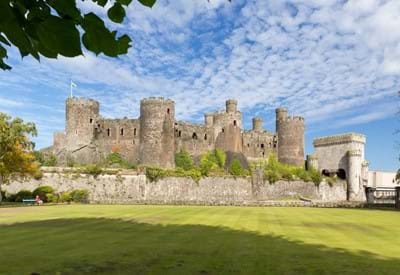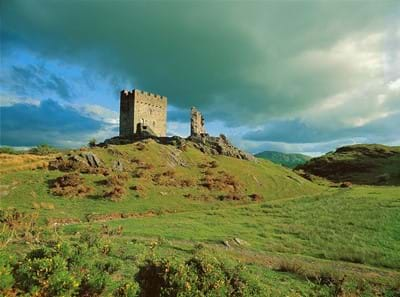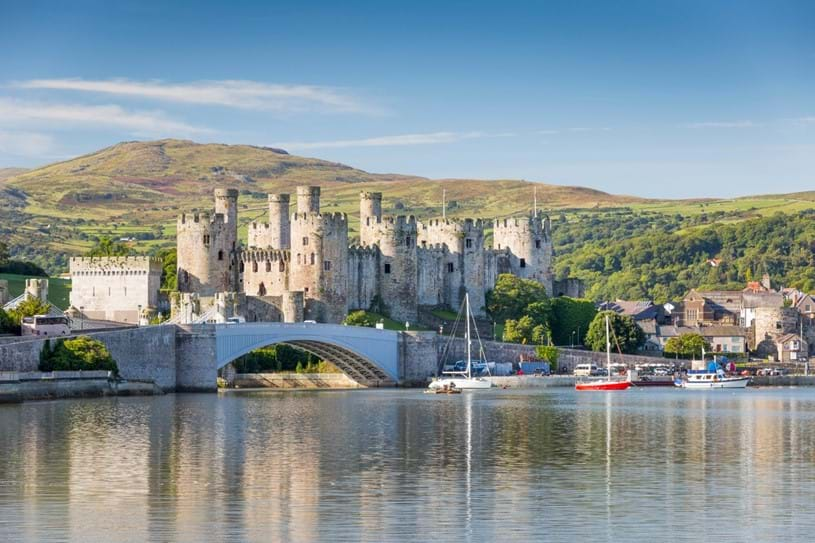Exploring the Magnificent Castles of North Wales
A holiday in Snowdonia won’t be complete without visiting one of our many world famous castles. Wales' turbulent history has left a landscape scattered with Iron Age hill forts, Roman ruins and Castles from Medieval Welsh princes and English kings. With over 400 castles, wherever you go in Wales, you won't be too far from a historic site. Wales has more castles per square mile than anywhere else in Europe. If you don’t have time to visit every single one, here are our favourites that are dotted around North Wales.

Dolwyddelan Castle: One of the most fascinating castles in Wales. Constructed by a Welsh Prince, Llywelyn ap Iorwerth (Llywelyn the Great) in the 12th century, it has been a witness to many battles and stories and played a key role in the wars between Wales and England. Located on a rocky outcrop, it offers a breathtaking view of the surrounding countryside. Dolwyddelan castle is an ideal destination for history lovers who want to explore its architecture and learn more about its past. From its stone walls to its secret passages, this castle has plenty of interesting features that make it an intriguing place to visit. Its location also offers great walking opportunities for outdoor enthusiasts. Today, it is a well-preserved castle ruin which was partially ‘restored’ with mediaeval-style battlements by Lord Willoughby de Eresby.
 Conwy Castle: A magnificent example of mediaeval architecture. Built by Edward I in the late 13th century as part of an effort to consolidate his control over this region, it is considered to be one of the most impressive castles in Britain, not only because of its size but also due to its stunning architecture; its eight massive towers, curtain walls, and arrow slits have withstood the test of time and remain intact today. The castle is surrounded by a stunning landscape and offers breathtaking views of the surrounding area. From its walls, you can see across the Conwy Estuary and towards Eryri (Snowdonia) National Park. It's no wonder why this castle has been a popular tourist destination for centuries and is a UNESCO World Heritage Site.
Conwy Castle: A magnificent example of mediaeval architecture. Built by Edward I in the late 13th century as part of an effort to consolidate his control over this region, it is considered to be one of the most impressive castles in Britain, not only because of its size but also due to its stunning architecture; its eight massive towers, curtain walls, and arrow slits have withstood the test of time and remain intact today. The castle is surrounded by a stunning landscape and offers breathtaking views of the surrounding area. From its walls, you can see across the Conwy Estuary and towards Eryri (Snowdonia) National Park. It's no wonder why this castle has been a popular tourist destination for centuries and is a UNESCO World Heritage Site.
 Caernarfon Castle: Another of Edward I’s castles, designed by the military architect Master James of George, recognised around the world as one of the greatest buildings of the Middle Ages. It took 47 years to build the castle, quay and the town walls at a cost of £25,000. The castle was built in the late 13th century on the site of a former Norman castle. Designed to be both a fortress and a royal palace, with a series of towers and gatehouses surrounding a central courtyard. The Eagle Tower, with its three great turrets and 18-feet thick walls, is the crowning glory of the castle and it's where the royalty would sleep in lofty splendour. It played a key role in the wars between England and Wales, and was later the site of Prince Charles’ investiture as Prince of Wales in 1969.
Caernarfon Castle: Another of Edward I’s castles, designed by the military architect Master James of George, recognised around the world as one of the greatest buildings of the Middle Ages. It took 47 years to build the castle, quay and the town walls at a cost of £25,000. The castle was built in the late 13th century on the site of a former Norman castle. Designed to be both a fortress and a royal palace, with a series of towers and gatehouses surrounding a central courtyard. The Eagle Tower, with its three great turrets and 18-feet thick walls, is the crowning glory of the castle and it's where the royalty would sleep in lofty splendour. It played a key role in the wars between England and Wales, and was later the site of Prince Charles’ investiture as Prince of Wales in 1969.
 Dolbadarn Castle is a stunning example of Welsh history and architecture. Located in North Wales and overlooking the waters of Llyn Padarn, this native 12th century castle was built by the Welsh prince Llywelyn the Great and served as a stronghold for his rule over Gwynedd. The castle's walls still stand today, providing visitors with an opportunity to explore its ancient ruins and learn about its fascinating past.
Dolbadarn Castle is a stunning example of Welsh history and architecture. Located in North Wales and overlooking the waters of Llyn Padarn, this native 12th century castle was built by the Welsh prince Llywelyn the Great and served as a stronghold for his rule over Gwynedd. The castle's walls still stand today, providing visitors with an opportunity to explore its ancient ruins and learn about its fascinating past.
 Harlech Castle: An iconic medieval fortress located in the town of Harlech, overlooking the Irish sea, with the mountains of Eryri as a backdrop. It has stood for centuries as a symbol of strength and power, and its historical significance is undeniable. Built by Edward I in the late 13th century, it was the site of several important battles during the Wars of Welsh Independence. Its impressive architecture and setting has made it a popular tourist destination, and its cultural importance to Wales is recognized by UNESCO, who designated it as a World Heritage Site in 1986. The Mighty Harlech Castle stands today as an enduring reminder of Wales's turbulent past and its importance to European history.
Harlech Castle: An iconic medieval fortress located in the town of Harlech, overlooking the Irish sea, with the mountains of Eryri as a backdrop. It has stood for centuries as a symbol of strength and power, and its historical significance is undeniable. Built by Edward I in the late 13th century, it was the site of several important battles during the Wars of Welsh Independence. Its impressive architecture and setting has made it a popular tourist destination, and its cultural importance to Wales is recognized by UNESCO, who designated it as a World Heritage Site in 1986. The Mighty Harlech Castle stands today as an enduring reminder of Wales's turbulent past and its importance to European history.
 Beaumaris Castle: One of the last and most elaborate of Edward I’s castles, Beaumaris Castle was built between 1295 and 1330 with near-perfect symmetry, four concentric rings of formidable defences and a water-filled moat with its own dock, this was the largest and last of the castles created by Edward I in Wales. It was designed by James of St George and is considered to be one of his finest works. Despite its impressive design, the castle was never completed due to a lack of funds, but remains a magnificent example of mediaeval military architecture. Visitors can explore the castle, and learn about the history of this important site.
Beaumaris Castle: One of the last and most elaborate of Edward I’s castles, Beaumaris Castle was built between 1295 and 1330 with near-perfect symmetry, four concentric rings of formidable defences and a water-filled moat with its own dock, this was the largest and last of the castles created by Edward I in Wales. It was designed by James of St George and is considered to be one of his finest works. Despite its impressive design, the castle was never completed due to a lack of funds, but remains a magnificent example of mediaeval military architecture. Visitors can explore the castle, and learn about the history of this important site.
 Criccieth Castle: Is a medieval castle situated near the town of Criccieth. Dating back to the 13th century, it stands as an impressive reminder of Wales' turbulent past and its unique culture and heritage. Initially built by Llywelyn the Great with his grandson Llywelyn ap Gruffudd adding the outer ward, two new towers and the curtain wall, then Invaded by Edward l, who made further additions of his own, equipping one of the towers with a stone throwing machine. In 1404 Welsh leader Owain Glyndwr attacked, captured and burnt the castle, the town once again became fully Welsh without a garrison to safeguard it, even today the walls still bear evidence of the scorching. Today Criccieth Castle is open to the public allowing people to explore its walls and stone structures while learning about Welsh history first hand. As one of Wales' most significant historic sites, it provides an important glimpse into the past while highlighting the many contributions that Welsh kings made towards preserving Wales' rich cultural heritage.
Criccieth Castle: Is a medieval castle situated near the town of Criccieth. Dating back to the 13th century, it stands as an impressive reminder of Wales' turbulent past and its unique culture and heritage. Initially built by Llywelyn the Great with his grandson Llywelyn ap Gruffudd adding the outer ward, two new towers and the curtain wall, then Invaded by Edward l, who made further additions of his own, equipping one of the towers with a stone throwing machine. In 1404 Welsh leader Owain Glyndwr attacked, captured and burnt the castle, the town once again became fully Welsh without a garrison to safeguard it, even today the walls still bear evidence of the scorching. Today Criccieth Castle is open to the public allowing people to explore its walls and stone structures while learning about Welsh history first hand. As one of Wales' most significant historic sites, it provides an important glimpse into the past while highlighting the many contributions that Welsh kings made towards preserving Wales' rich cultural heritage.
Overall, the castles of North Wales are an important part of Welsh history and a testament to the region’s rich cultural heritage. They are popular tourist attractions and continue to fascinate visitors from around the world to this day.
Ni fydd gwyliau yn Eryri yn gyflawn heb ymweld ag un o'n cestyll byd enwog niferus. Mae hanes cythryblus Cymru wedi gadael tirwedd wedi'i gwasgaru â bryngaerau o'r Oes Haearn, adfeilion Rhufeinig a Chestyll o dywysogion Cymreig Canoloesol a brenhinoedd Lloegr. Gyda dros 400 o gestyll, ble bynnag yr ewch ar wyliau yng Nghymru ni fyddwch yn rhy bell o safle hanesyddol, mae gan Gymru fwy o gestyll fesul milltir sgwâr nag unrhyw le arall yn Ewrop. Os nad oes gennych amser i ymweld â phob un, dyma rai o'r cestyll gorau o amgylch Betws-y-coed.
 Castell Dolwyddelan: Un o'r cestyll mwyaf diddorol yng Nghymru. Fe'i lluniwyd gan Dywysog Cymreig, Llywelyn ap Iorwerth neu Llywelyn Fawr yn y 12fed ganrif, ac mae wedi bod yn dyst i nifer o frwydrau a straeon ac wedi chwarae rhan allweddol yn y rhyfeloedd rhwng Cymru a Lloegr. Wedi'i leoli ar frigiad creigiog, mae'n cynnig golygfa syfrdanol o'r cefn gwlad o'i amgylch. Mae Castell Dolwyddelan yn gyrchfan ddelfrydol i bobl sy'n hoff o hanes ac sydd am archwilio ei bensaernïaeth a dysgu mwy am ei orffennol. O'i waliau cerrig i'w ddarnau cyfrinachol, mae gan y castell hwn ddigon o nodweddion diddorol sy'n ei wneud yn lle diddorol i ymweld ag ef. Mae ei leoliad hefyd yn cynnig cyfleoedd cerdded gwych i selogion awyr agored. Heddiw, mae'n adfail castell sydd wedi'i gadw'n dda a gafodd ei 'adfer' yn rhannol gyda bylchfuriau yn y dull canoloesol gan yr Arglwydd Willoughby de Eresby.
Castell Dolwyddelan: Un o'r cestyll mwyaf diddorol yng Nghymru. Fe'i lluniwyd gan Dywysog Cymreig, Llywelyn ap Iorwerth neu Llywelyn Fawr yn y 12fed ganrif, ac mae wedi bod yn dyst i nifer o frwydrau a straeon ac wedi chwarae rhan allweddol yn y rhyfeloedd rhwng Cymru a Lloegr. Wedi'i leoli ar frigiad creigiog, mae'n cynnig golygfa syfrdanol o'r cefn gwlad o'i amgylch. Mae Castell Dolwyddelan yn gyrchfan ddelfrydol i bobl sy'n hoff o hanes ac sydd am archwilio ei bensaernïaeth a dysgu mwy am ei orffennol. O'i waliau cerrig i'w ddarnau cyfrinachol, mae gan y castell hwn ddigon o nodweddion diddorol sy'n ei wneud yn lle diddorol i ymweld ag ef. Mae ei leoliad hefyd yn cynnig cyfleoedd cerdded gwych i selogion awyr agored. Heddiw, mae'n adfail castell sydd wedi'i gadw'n dda a gafodd ei 'adfer' yn rhannol gyda bylchfuriau yn y dull canoloesol gan yr Arglwydd Willoughby de Eresby.
 Castell Conwy: Enghraifft wych o bensaernïaeth ganoloesol. Fe'i hadeiladwyd gan Edward I ar ddiwedd y 13eg ganrif fel rhan o ymdrech i atgyfnerthu ei reolaeth dros y rhanbarth hwn, fe'i hystyrir yn un o'r cestyll mwyaf trawiadol ym Mhrydain, nid yn unig oherwydd ei faint ond hefyd oherwydd ei bensaernïaeth syfrdanol; mae ei wyth tŵr enfawr, llenfur, a holltau saeth wedi gwrthsefyll prawf amser ac yn parhau i fod yn gyfan hyd heddiw. Mae'r castell wedi'i amgylchynu gan dirwedd drawiadol ac mae'n cynnig golygfeydd godidog o'r ardal gyfagos. O'i waliau, gallwch weld ar draws Aber Afon Conwy a thuag at Barc Cenedlaethol Eryri. Does ryfedd fod y castell hwn wedi bod yn gyrchfan boblogaidd i dwristiaid ers canrifoedd ac yn Safle Treftadaeth y Byd UNESCO.
Castell Conwy: Enghraifft wych o bensaernïaeth ganoloesol. Fe'i hadeiladwyd gan Edward I ar ddiwedd y 13eg ganrif fel rhan o ymdrech i atgyfnerthu ei reolaeth dros y rhanbarth hwn, fe'i hystyrir yn un o'r cestyll mwyaf trawiadol ym Mhrydain, nid yn unig oherwydd ei faint ond hefyd oherwydd ei bensaernïaeth syfrdanol; mae ei wyth tŵr enfawr, llenfur, a holltau saeth wedi gwrthsefyll prawf amser ac yn parhau i fod yn gyfan hyd heddiw. Mae'r castell wedi'i amgylchynu gan dirwedd drawiadol ac mae'n cynnig golygfeydd godidog o'r ardal gyfagos. O'i waliau, gallwch weld ar draws Aber Afon Conwy a thuag at Barc Cenedlaethol Eryri. Does ryfedd fod y castell hwn wedi bod yn gyrchfan boblogaidd i dwristiaid ers canrifoedd ac yn Safle Treftadaeth y Byd UNESCO.
 Castell Caernarfon: Un arall o gestyll Edward I, a ddyluniwyd gan y pensaer milwrol Master James of George, a gydnabyddir ledled y byd fel un o adeiladau mwyaf yr Oesoedd Canol. Cymerodd 47 mlynedd i adeiladu'r castell, y cei a muriau'r dref ar gost o £25,000. Adeiladwyd y castell ar ddiwedd y 13eg ganrif ar safle hen gastell Normanaidd. Wedi'i gynllunio i fod yn gaer ac yn balas brenhinol, gyda chyfres o dyrau a phorthdai o amgylch cwrt canolog. Tŵr yr Eryr, gyda'i dri thyred mawr a'i waliau 18 troedfedd o drwch, yw gogoniant mwya’r castell a dyma lle byddai'r teulu brenhinol yn cysgu mewn ysblander uchel. Chwaraeodd ran allweddol yn y rhyfeloedd rhwng Cymru a Lloegr, ac yn ddiweddarach roedd yn safle arwisgiad Tywysog Charles fel Tywysog Cymru ym 1969
Castell Caernarfon: Un arall o gestyll Edward I, a ddyluniwyd gan y pensaer milwrol Master James of George, a gydnabyddir ledled y byd fel un o adeiladau mwyaf yr Oesoedd Canol. Cymerodd 47 mlynedd i adeiladu'r castell, y cei a muriau'r dref ar gost o £25,000. Adeiladwyd y castell ar ddiwedd y 13eg ganrif ar safle hen gastell Normanaidd. Wedi'i gynllunio i fod yn gaer ac yn balas brenhinol, gyda chyfres o dyrau a phorthdai o amgylch cwrt canolog. Tŵr yr Eryr, gyda'i dri thyred mawr a'i waliau 18 troedfedd o drwch, yw gogoniant mwya’r castell a dyma lle byddai'r teulu brenhinol yn cysgu mewn ysblander uchel. Chwaraeodd ran allweddol yn y rhyfeloedd rhwng Cymru a Lloegr, ac yn ddiweddarach roedd yn safle arwisgiad Tywysog Charles fel Tywysog Cymru ym 1969








